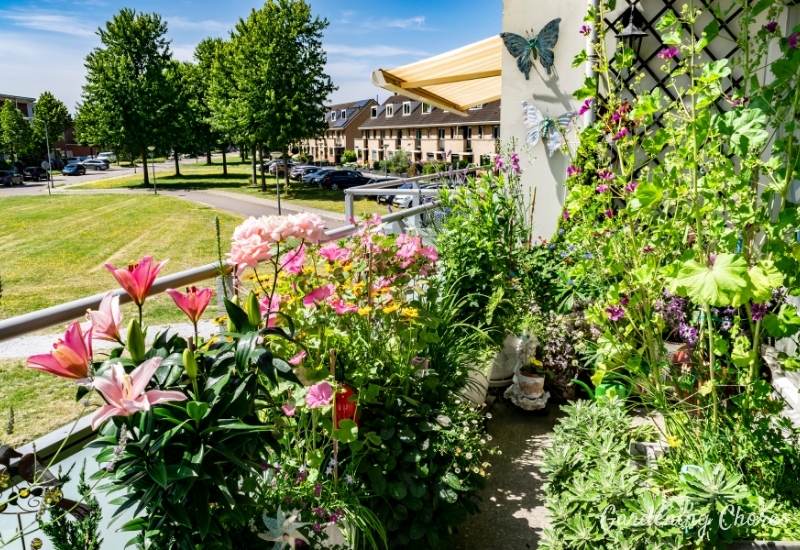
Plants and flowers look magnificent in the Sun. The light on their foliage and beautiful petals just makes them shine like stars in the sky. Attractive pots and decorative containers and lots of sunlight on terraces and patios with healthy plants can turn even a small balcony into a small tropical paradise.
However, that paradise can turn into a desert if you choose the wrong plants…
So, When it comes to growing beautiful containers especially in areas with full sun, it all starts with the best container plants that thrive in full sun also also tolerant of drought and arid conditions.
Quite a few plants like lots of sunshine, and a fair few like string heat. These are often quite showy and exotic looking plants, like gloriosa lilies or sand aloe.
However, plants that cannot stand the heat (and excessive light) will likely die in these conditions. Heat and light are two different factors you will need to calculate.
Finding heat-loving container plants for full sun takes patience and sometimes lots of research. When we find flowering plants that will look great in the light of the sun, and grow strong in hot places and climates, we tend to keep planting them.
Let’s learn more about choosing heat-loving container plants for full sun along with tips to get the most from your container garden for sunny areas.
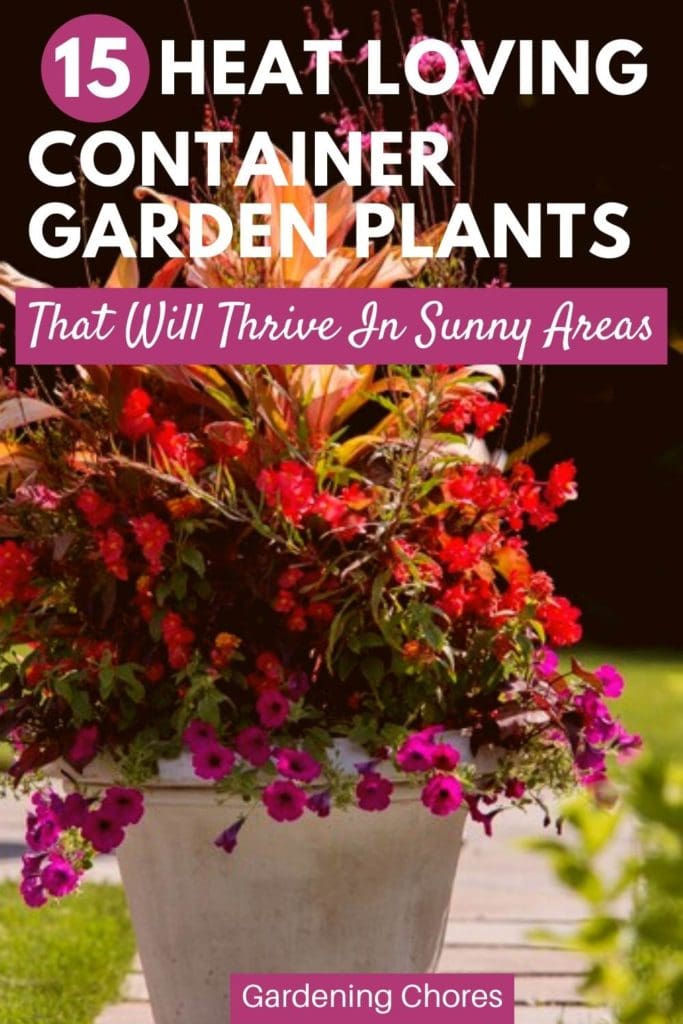
Growing Container Plants in Full sun
Most people believe that every plant loves full Sun conditions, but this is not true. And especially if you want to grow them in containers, you need to be careful.
Many do not like direct sunlight and some cannot stand very high temperature. So, the first thing you will need to do is choose a container plant that grows well in hot and sunny places. But this is not enough…
Because plants with roots in the ground can access water, nutrients and even fresh temperatures more readily than in containers, you will need to use extra care.
To start with, choose your container carefully. Porous containers (terracotta, wood, even concrete) will dry up very fast. Plastic and in general non porous containers will not dry up so fast, but they will not even aerate the roots as well…
So, do keep an eye on how moist the soil is and water your plants whenever necessary, which will be more often that with the same plants growing in the ground.
If the weather is particularly dry and your plant loves humid air, do use a large saucer and leave a thin layer of water there. Do remember that succulents do not like humid air though.
You may also need to use a “trick of the trade” with some plants. If the heat is excessive, but your green companion likes lots of light, shelter the pot while leaving the aerial part of the plant in full Sun.
In fact, very often it is the roots that feel too hot, and the leaves start drooping or become flaccid as a consequence.
Understanding Sun and Heat
Everything has a flip side. So, while many gardeners are desperate to get more sunlight and heat, especially in cold places like Canada, too much of each can be a problem for your plants. But what is the difference between “plenty” and “excessive”?
Light and Sunlight
Sunlight is far more complex than many people think. You know that by “full Sun” we mean “more than 6 hours of full light every day”. It does not mean sunlight all day round, nor does it mean total darkness during the other hours.
But there are other properties of light you should consider. The intensity of light, which is usually stronger in countries nearer the equator, is one.
But there is also the diffusion of light. Diffuse or refracted light is usually better, especially indoors. Direct sunlight indoors is, in fact, often problematic, as it risks burning your plants.
Finally, if you have indoor containers in mind, beware of window panes. These work as lenses and they can literally ruin your plants, causing leaf burn and edge burn.
Heat
Too much heat can cause dehydration and general stress to your plant. It may even encourage disease if matched with humidity and lack of ventilation. So, the better ventilated a place is, the less risky excessive heat will be.
But there is more… Different regions will have, on average, different climate and heat… But gardeners and botanists have come up with a great solution to help you along.
Like with USDA hardiness zones, which tell you if your area is warm enough for a certain plant in winter, we also have heat tolerance zones.
Heat Tolerance Zones (AHS)
A heat tolerance zone depends on the average days above 86o F (30o C) you get in a certain area. So, zone 1 has fewer than 1 day a year. This only happens in Canada and Alaska in the New Continent…
At the other end of the scale, you have zone 12, with more than 210 days a year above this temperature. Mexico, the south of Florida and Texas are in this zone.
Thankfully, botanists have mapped these well for Canada and the USA, so, in this article, you will also find details on the heat tolerance zone for each plant.
15 Heat-Tolerant Container Garden Plants For Full Sun
If you’re looking for showy flowers with strong colors, shiny leaves and sometimes exotic looking container plants can look wonderful in that sunny spot on your patio or terrace. Try one of these 15 recommended container garden plants that will thrive full sun and heat:
1: Canna Lily (Canna indica)
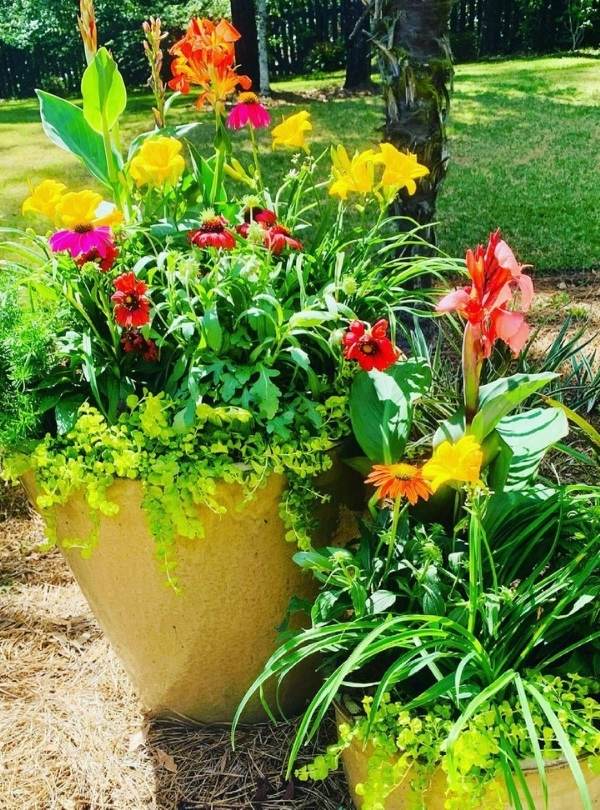
Canna lily says “lush and tropical” but also “hot and sunny” like few other flowering plants in the world! It has broad fleshy and glossy lanceolate leaves, sometimes veined, sometimes even dark purple. These upward from the base of the plant, and they alone give you a tropical and exotic landscape.
But wait till you see the large, brightly colored and tropical looking flowers on top of the long stems! They come in small groups at eye level, just to make sure you don’t miss the bright yellow, orange or red they offer to liven up your garden, container, patio or terrace.
They have another quality though… Canna lilies are very generous! They will propagate naturally, forming exotic clumps in a matter of months, and they will bloom readily and abundantly.
No wonder they have become one of the most popular plants in public and private gardens in many hot countries around d the world.
- Hardiness: canna lily is hardy to USDA zones 8 to 11.
- Heat tolerance zones: 1 to 12, so, very flexible.
- Light exposure: full Sun.
- Size: 2 to 3 feet tall (60 to 90 cm) and 1 to 2 feet in spread (60 to 90 cm).
- Soil requirements: it is very adaptable. It needs well drained and regularly watered soil of most types: loam, chalk, clay or sand. The pH can go from slightly alkaline to slightly acidic.
2: Angel’s Trumpet (Brugmansia spp.)
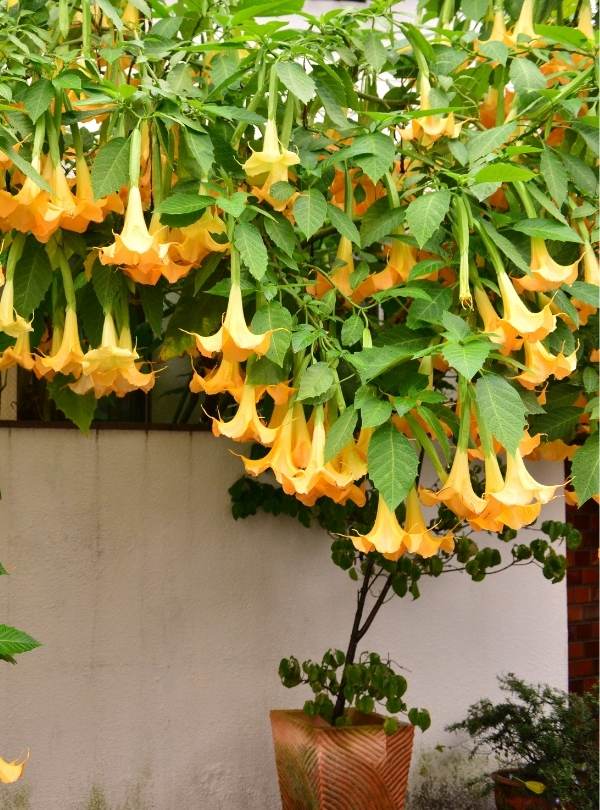
For a sunny terrace or patio in the Sun, angel’s trumpet is just perfect for growing in containers. This small tree or shrub has lush and glossy foliage but what makes it stand out is the abundance of large, trumpet like flowers that hang from its branches. They are, in fact, up to 10 inches long (25 cm) and about 8 inches wide (20 cm)!
There are many varieties, with flowers of different colors too. So, the classical ‘Betty Marshall’ is snow white, ‘Charles Grimaldi’ is bright yellow, and ‘Cherub’ is salmon pink… But if you want energy and passion, choose Brugmansia sanguinea, which has the most vibrant shades of red ever!
This heat and Sun loving plant grows well in containers, where it won’t reach the large size it does in the ground. It will fill your patio or terrace with dozens of massive flowers from summer to fall.
- Hardiness: angel’s trumpet is usually hardy to USDA zones 9 to 11.
- Heat tolerance zones: it’s a heat loving plant… zones 10 to 11.
- Light exposure: full Sun or partial shade.
- Size: 10 to 15 feet in height and spread (3 to 4.5 meters) in full soil. In pots its size will be smaller.
- Soil requirements: it is adaptable to loam, chalk, clay or sandy soil, as long as well drained and kept humid. The pH can go from slightly acidic to slightly alkaline comfortably (ideally between 5.5 and 7.0, which is a fairly wide range), but it prefers it on the acidic side.
3: Egyptian Star Flower (Pentas lanceolata)
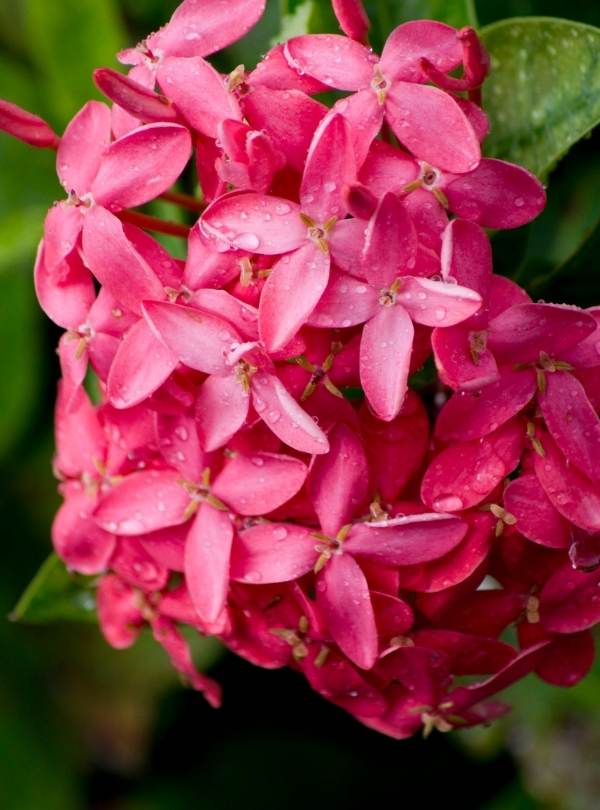
Egyptian star flower is an exotic looking bush that you can easily grow in containers and pots as a perennial or as an annual.
It has lush and vibrant green foliage which will stay on the branches most of the year if you have it as a perennial. The leaves are oval and shiny, large (4 inches, or 10 cm long) and very decorative.
But this heat and Sun loving plant takes its name from its summer blossoms. In fact, in this season it will fill with large clusters of star shaped flowers that can be lilac, pink, white or red. These are showy and they are a real magnet for hummingbirds and butterflies.
- Hardiness: Egyptian star flower is hardy to USDA zones 10 to 11.
- Heat tolerance zones: 1 to 11, very adaptable indeed
- Light exposure: full Sun.
- Size: 2 to 3 feet in height and spread (60 to 90 cm).
- Soil requirements: it will like organically rich and well drained generic potting soil. Alternatively, well drained loam, clay, chalk or sandy soil, with pH from slightly acidic to slightly alkaline.
4: Okra (Abelmoschus esculentus)
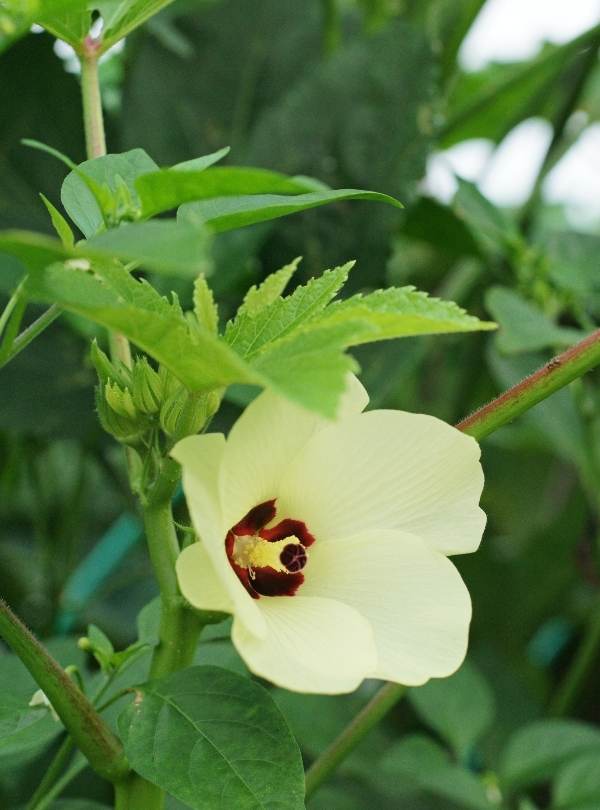
You may know okra mainly as a vegetable, but this Sun and heat tolerant plant also has stunning flowers! They look a bit like those of hibiscus, with creased paper looking petals and a purple center. The petals though, can be white or lime yellow and so e varieties have magenta purple veins.
On top of the large flowers (3 inches across, or 7 cm) from spring to summer, you will also get beautiful palmate leaves and, of course, decorative as well as nutritious pods! And all this can happen in a fairly small pot or container on your terrace or patio.
- Hardiness: okra is hardy to USDA zones 2 to 12.
- Heat tolerance zones: it is extremely adaptable, to zones 1 to 12!
- Light exposure: full Sun.
- Size: between 3 and 5 feet in height and spread (90 to 150 cm).
- Soil requirements: any moderately fertile potting soil will do, as long as well drained. If you want to use soil from your garden, well drained loam, clay or sand with pH between 6.0 and 6.8.
5: African Lily (Agapanthus spp.)
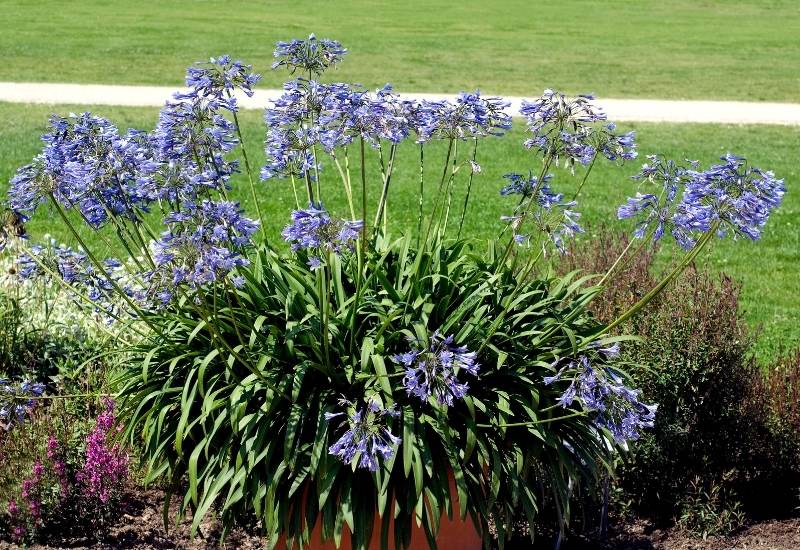
The huge globular inflorescences of African lily look stunning in the Sun, and they are at their best on. Hot summer days.
They can easily be more than 12 inches (30 cm) in diameter and some varieties like ‘Brilliant Blue’ can have more than 100 brightly colored flowers in each umbrel!
You can choose between the soft and innocent looking ‘Arctic Star’ with its white flowers, or the deep, almost electric blue and drooping flowers of ‘Black Buddhist’, or maybe you prefer ‘Fireworks’, with flowers that start violet at the stem and turn white at the edges?
Whichever your choice, African lilies are very tolerant to heat and sunshine and the look like works of art in containers on patios, terraces, but even in gravel gardens or on the steps to your main door!
- Hardiness: African lily is hardy to USDA zones 8 to 11.
- Heat tolerance zones: it is tolerant to AHS zones 1 to 12, so… all!
- Light exposure: full Sun but also partial shade.
- Size: between 1 and 3 feet tall and in spread (30 to 90 cm).
- Soil requirements: well drained and fertile potting soil. Adaptable to loam, clay, chalk or sandy soil with slightly acidic to neutral pH, it should be under 6.5 in fact and never more than 6.9.
6: ‘Blue Glow’ Agave (Agave ‘Blue Glow’)
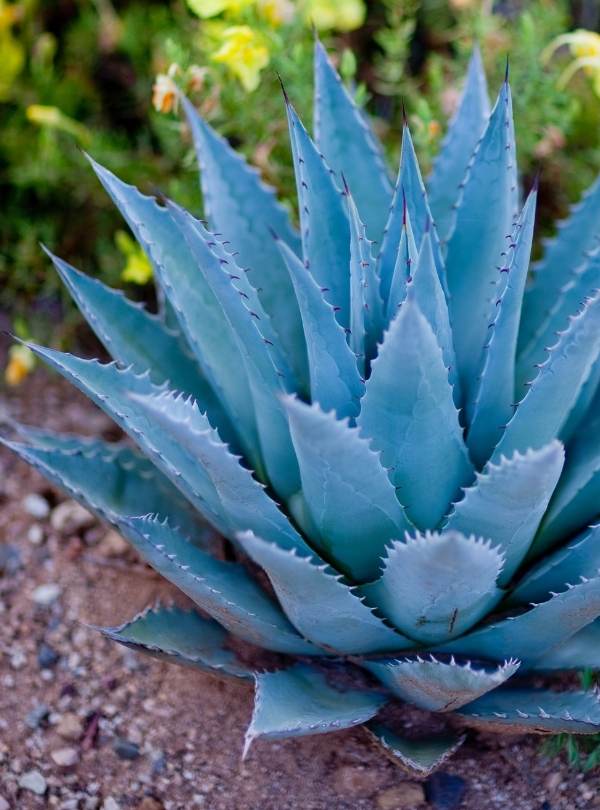
Any small species or variety of agave will look great in the Sun on your terrace or patio. But ‘Blue Glow’ has something exceptional… It has very glossy, blade like leaves that reflect the light as if they were made of jade.
But wait… the leaves are blue but with yellow green line towards the edges which lets the sunlight through. The whole is topped off with a copper line around the edges of the leaf.
This plant really looks like a sculpture! The good news is that it is quite easy to grow and long lasting and that now you can source it very easily.
So, you top can have this jaw dropping elegant and vibrant wonder in a container or pot to wow your visitors.
- Hardiness: Agave ‘Blue Glow’ is hardy to USDA zones 8 to 11.
- Heat tolerance zones: it grows well in AHS zones 5 to 11.
- Light exposure: full Sun but also partial shade.
- Size: 1 to 2 feet tall (30 to 60 cm) and 2 to 3 feet wide (60 to 90 cm).
- Soil requirements: it will need very well drained, loose and light cactus potting soil. It should not be very rich in organic matter, as this may withhold moisture and cause root rot. Very well drained loam and sandy loam are fine too. The pH should be acidic to neutral (slightly acidic is better, never above 6.8). It is drought and salt resistant.
7: Sand Aloe (Aloe hereroensis)
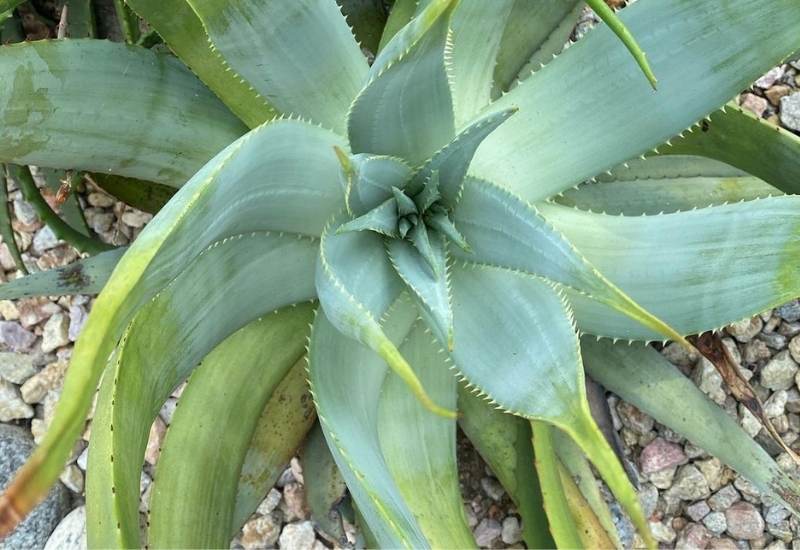
Is your terrace small, but sunny and hot? Do you want to have the unique presence of an aloe but you can’t afford much space? Sand aloe is a stunning and original relative of the bigger and more famous Aloe vera.
The name comes from its color, which is bluish grey with pink edges. It has thin and elegant stripes running along the pointed leaves which have “teeth” on the sides and tend to curl a bit sideways.
Along these lines, you will also find regular spots, as if someone had used a toothpick to draw a regular pattern.
These qualities make sand aloe an outstanding choice for any balcony, terrace, sand or gravel garden or patio that needs an architecturally notable yet also very elegant and sophisticated plant.
It brings an original touch and interpretation of the classical aloe shape and colors and it will bloom profusely from late spring / early summer to fall. The flowers will come on flattened racemes and they are tubular and waxy, usually scarlet red, but sometimes yellow or orange.
- Hardiness: sand aloe is hardy to USDA zones 9 to 11.
- Heat tolerance zones: AHS zones 10 to 12 only, so, lots of heat.
- Light exposure: full Sun.
- Size: 1 to 2 feet in height and spread (30 to 60 cm).
- Soil requirements: use well drained, loose and light cactus potting compost. Alternatively, loam or sandy loam, always well drained and light (with little organic matter). It prefers a slightly alkaline pH, but neutral will do (ideally between 7.9 and 8.5). Drought resistant, this plant does not stand “wet feet”. Only water it once the soil has dried up completely.
8: Belladonna Lily (Amaryllis belladonna)
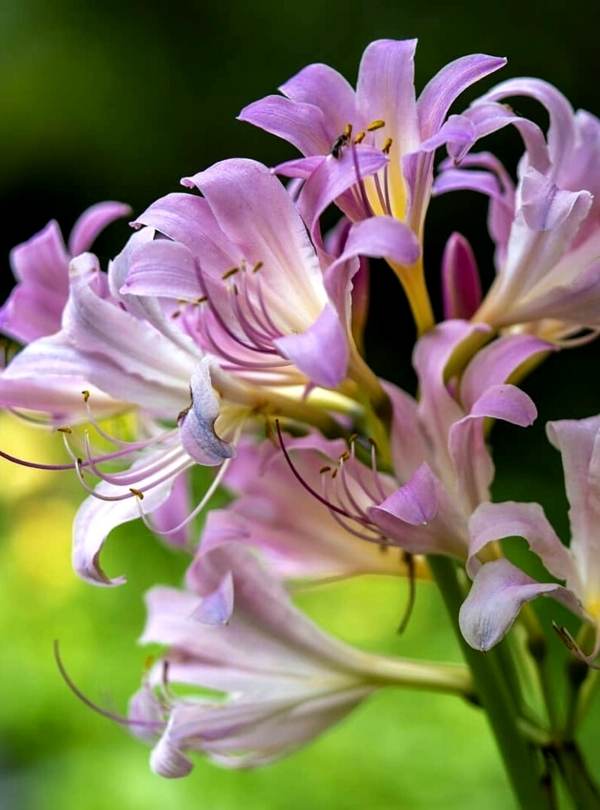
If you want large and showy flowers in your containers in the sun, belladonna lily will happily oblige you in late summer and fall.
This is a close relative to the more popular “indoor” amaryllis, but it’s less demanding, easy to grow and it can even be naturalized easily.
In fact, you can now see these beautiful pink flowers with a yellow center growing both on pots and gardens in many warm regions, especially around the Mediterranean, where they keep blooming and year after year and propagate spontaneously.
This is an excellent flower for late summer “floral fireworks”. It has won the Award of Garden Merit by the Royal Horticultural Society, but be careful: all parts of belladonna lily are poisonous.
- Hardiness:
- Heat tolerance zones: belladonna lily is hardy to USDA zones 7 to 10.
- Light exposure: AHS zones 7 to 11.
- Size: 2 to 3 feet in height and spread (60 to 90 cm).
- Soil requirements: well drained, moderately fertile and loose potting compost. Alternatively, loam, chalk or sandy loam, well drained and with pH between 6.0 and 8.0, but ideally under 6.8 (slightly acidic to neutral, but it will adapt to slightly alkaline).
9: Taro ‘Black Coral’ (Colocasia esculenta ‘Black Coral’)
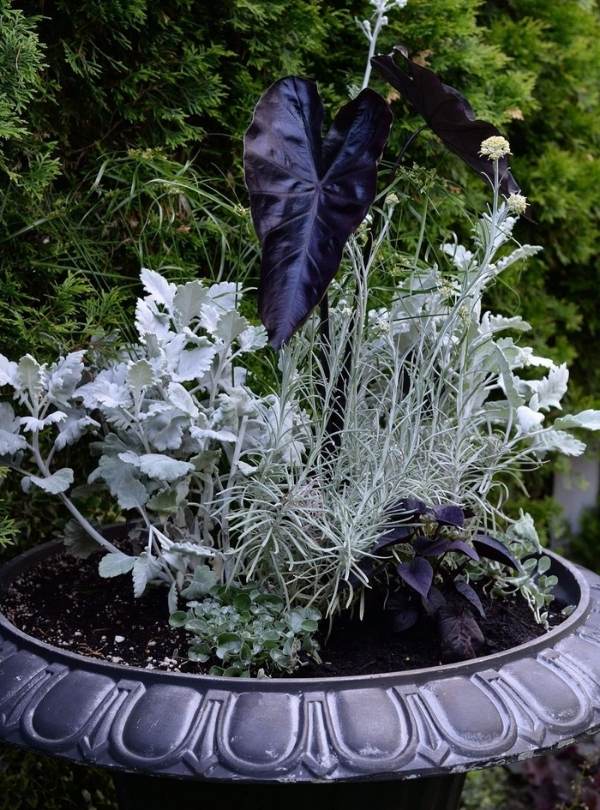
Hold your breath… Imagine huge heart shaped leaves with dark blue ribbed veins radiating from the petiole… Make them 3 feet long (90 cm) and 2 feet wide (60 cm)!
Now, paint it black and put it in the Sun! That’s taro ‘Black Coral’ for you.
Black in plants is not just unusual. It reflects the light enhancing their sculptural beauty, and at the same time it creates color effects with the many underlying shades of “black”, which in Nature is always a mix of many dark colors (blue and purple, mainly).
But the effect does not end with the top of the leaves… The bottom, which also appears black, reflects the light with the most amazing colors, including, quite prominently, gold!
This is a stunning plant, excellent as a highly decorative potted perennial in tropical or even very modern and artistic terraces, gravel gardens and patios.
It also flowers very profusely, with flowers that look a bit like lilies and have yellow green spathes. Most taros do not like full Sun positions, but ‘Black Coral’ actually likes it.
- Hardiness: taro ‘Black Coral’ is hardy to USDA zones 7 to 12.
- Heat tolerance zones: AHS zones 8 to 12.
- Light exposure: full Sun or partial shade.
- Size: 3 to 4 feet tall (90 to 120 cm) and 2 to 3 feet wide (60 to 90 cm).
- Soil requirements: it wants organically rich, loose and well drained potting soil, which you need to keep moist. If you want to use garden soil, clay, loam or sandy soil, and it will tolerate wet soil. The pH needs to be from acidic to neutral.
10: Swamp Lily (Crinum americanum)
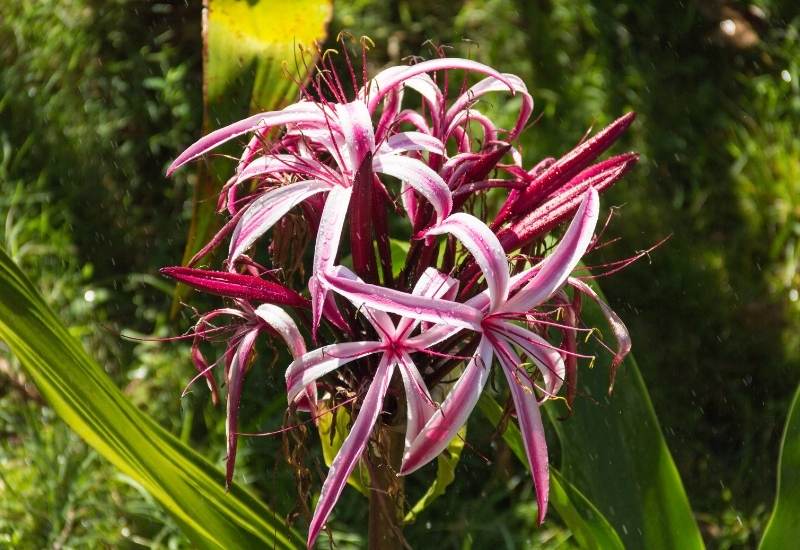
These Sun loving flowers look like large white stars, and they come in groups that seem to float on top of their long and thin blade like leaves.
The petals may turn slightly pink as they mature, but the effect in your containers or pots is still beautiful and nicely scented too.
And you won’t get just one bloom with swamp lily; you will get many from early summer through fall.
Just make sure you give this plant plenty of water, as in the wild, it likes to grow next to ponds and rivers.
- Hardiness: swamp lily is hardy to USDA zones 8 to 11.
- Heat tolerance zones: AHS zones 8 to 11.
- Light exposure: full Sun or part shade, but it performs better in full Sun.
- Size: 2 to 3 feet tall (60 to 90 cm) and 1 to 2 feet in spread (30 to 60 cm).
- Soil requirements: the soil needs to be very well drained but at the same time moist all the time and organically rich. Chalk, loam or sandy loam from the garden will do, with pH from acidic to neutral.
11: Mediterranean Sea Holly (Eryngium bourgatii ‘Picos Amethyst’)
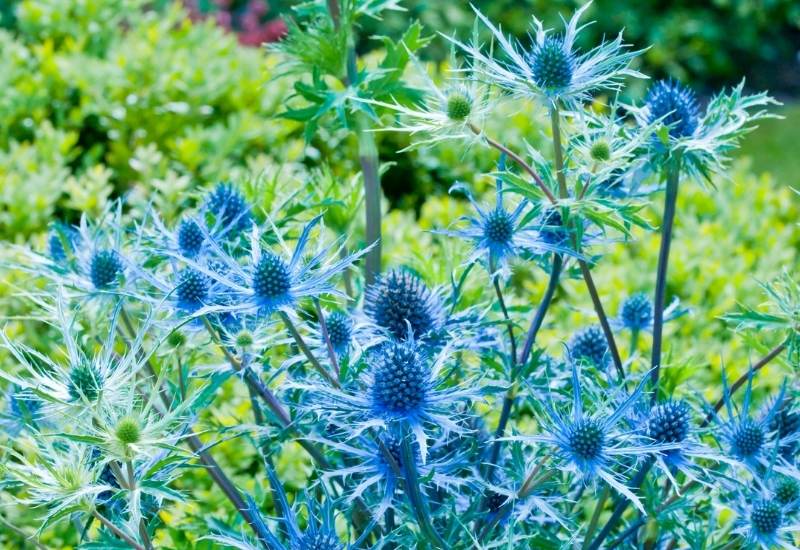
If you want your container plants to show vibrant yet elegant wild rebelliousness, this thistle like flowering plant has both the savage look and the extra decorative touch.
In fact, the leaves at the base of this shrub are green, but when the flowers come…
They have the most striking, almost luminous amethyst blue color and matching spiky bracts to show them off even further.
This is an excellent plant for a dry, desert looking patio, gravel garden or terrace, but also if you are planning on conveying a surreal and otherworldly look to your gardening effort.
- Hardiness: Mediterranean sea holly is hardy to USDA zones 4 to 9.
- Heat tolerance zones: AHS zones 5 to 9.
- Light exposure: full Sun.
- Size: 1 to 2 feet tall and wide (30 to 60 cm).
- Soil requirements: it likes well drained soil, even poor or with moderate fertility. It is drought and salt resistant and it will do well in loam, chalk or sand. The pH can be slightly acidic to slightly alkaline.
12: Pineapple Lily (Eucomis comosa ‘Sparking Burgundy’)
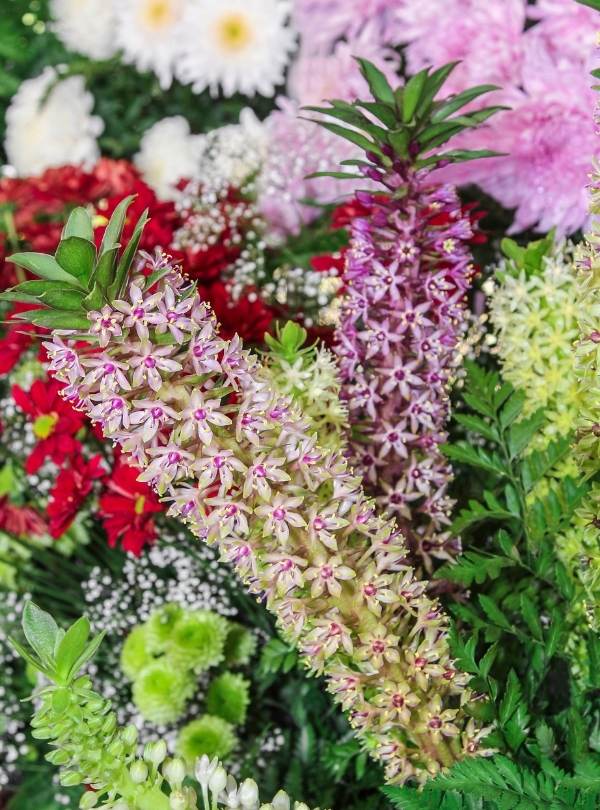
With star shaped purple pink flowers opening in succession on long racemes, pineapple lily ‘Sparkling Burgundy’ has won the Award of Garden Merit by the Royal Horticultural Society.
It will also leave purple stems after the bloom, which are quite decorative in fall.
The stems are long and upright, so, you can use this plant to give a vertical push to your containers and pots. The leaves too are quite attractive and long, and of a purplish red color too.
- Hardiness: pineapple lily is hardy to USDA zones 7 to 10.
- Heat tolerance zones: AHS zones 1 to 12!
- Light exposure: full Sun.
- Size: 2 to 3 feet tall (60 to 90 cm) and 1 to 2 feet in spread (30 to 60 cm).
- Soil requirements: rich and well drained generic potting soil will be excellent. Alternatively, loam, chalk or sandy soil with pH ranging from slightly acidic to slightly alkaline.
13: Treasure Flower (Gazania spp.)
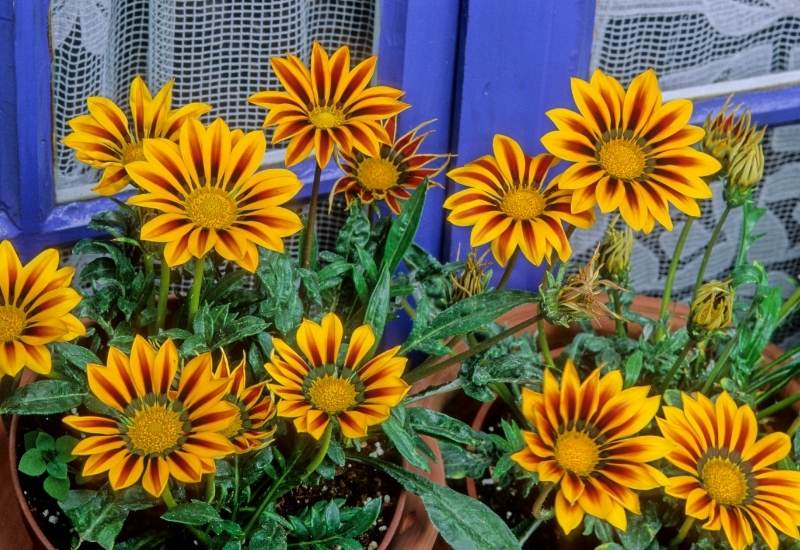
Few flowers are as “sunny” in appearance as treasure flower. Their pointed petals in fact look like Sun rays painted by some ancient civilization…
They have large golden disks in the middle and each petal has a main color (white to fold and dark yellow) and a darker stripe in the middle, from dark orange to purple. The petals are very glossy and reflect the light wonderfully well.
Despite being original of Africa, they remind me of Inca or South American paintings. They will bring energy and brightness to your pots and containers from late spring to late summer, making the best of sunny days with painted Suns on your terrace.
- Hardiness: treasure flower is hardy to USDA zones 8 to 10.
- Heat tolerance zones: AHS zones 8 to 10.
- Light exposure: full Sun.
- Size: 8 to 10 inches tall (20 to 25 cm) and 6 to 8 inches in spread (15 to 20 cm).
- Soil requirements: it likes well drained potting soil, with plenty of sand in it. Sandy loam or loam if you use garden soil and the pH from 5.5 to 7.0.
14: Gloriosa Lilies (Gloriosa spp.)
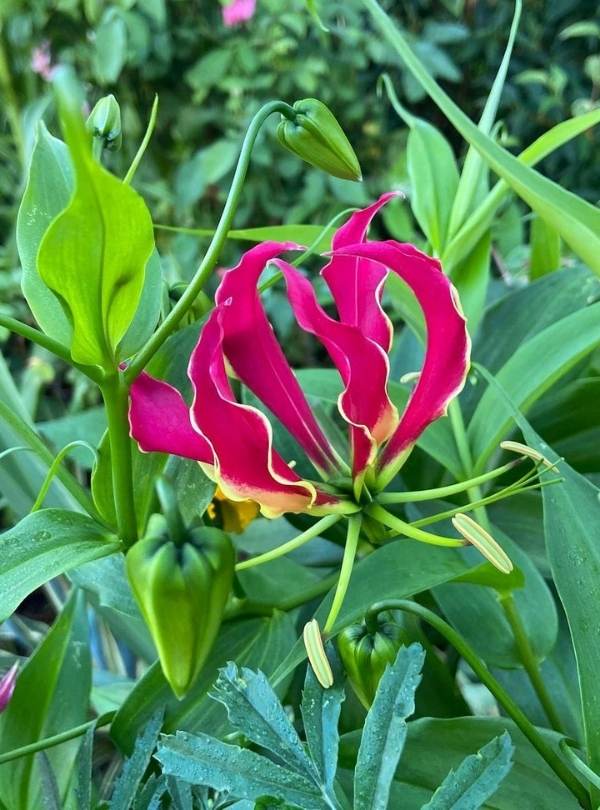
Of all Sun loving lilies, gloriosa is one of the most striking. Its petals turn backwards and upright, like cyclamen’s, and they also curl at the sides, giving this exotic looking flower a unique dynamic energy.
Their shape and vibrant colors are excellent to express passion and even drama. The main palette is from yellow to flaming red, but there are white flowers too and combinations that accentuate their “troubled and distraught” shape.
These tropical vines are excellent in pots next to pergolas, walls, gazebos and trellises and they will keep blooming from late spring all the way to fall.
- Hardiness: gloriosa lilies are hardy to USDA zones 8 to 10.
- Heat tolerance zones: AHS zones 7 to 11.
- Light exposure: full Sun but also partial shade.
- Size: 3 to 6 feet tall and in spread (90 to 180 cm)
- Soil requirements: gloriosa lilies want very rich and well drained potting soil. Loam is fine if you want to use garden soil. No other type of soil will do. The pH needs to be between 5.8 and 6.5.
15: Parrot Heliconia (Heliconia psittacorum)
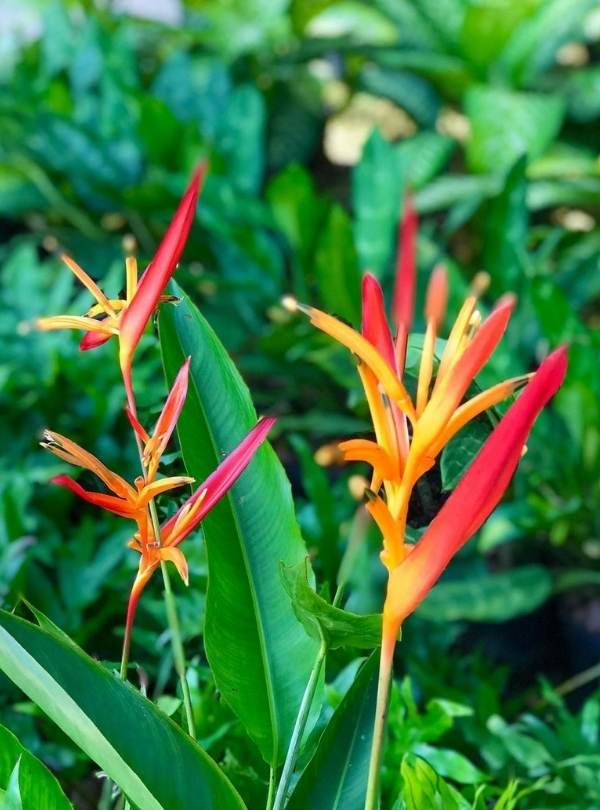
You can recreate a living tropical scene on your patio or terrace thanks to parrot heliconia. In fact, its long, glossy, green and spear like leaves growing on long stems will create a perfect “rainforest setting’ for what look like colorful birds… But they are not actually parrots…
The flowers of this perennial plant can be red, orange, green or yellow and they look like winged guests to this lush forest of dense leaves…
This is because the bracts, which have a very waxy and bright texture, are arranged at the sides of the flowers, giving you the impression of small wings.
This is a very playful plant to grow in containers, but also a fairly easy and generous one.
- Hardiness: parrot heliconia is hardy to USDA zones 10 to 11.
- Heat tolerance zones: AHS zones 10 to 11.
- Light exposure: full Sun but it will manage in partial shade too.
- Size: 3 to 6 feet tall (90 to 180 cm) and 2 to 3 feet in spread (60 to 90 cm).
- Soil requirements: it wants a very well drained, humus rich soil, which you need to keep constantly moist. Loam or sandy loam if you use garden soil and with a pH from acidic to neutral.
A Green Place in the Sun
Sun loving plants are really stunning, you must agree… They are very colorful, often bold and daring in their looks and colors.
Then, of course, plenty of light also means having those interesting reflections, unexpected colors and shades… And there are plants that rally make the best of light tricks and games.
They can be used for many looks: from exotic and tropical to Mediterranean and dry, from traditional and relaxing to modern and surreal. The choice is yours.
We have seen some of the most interesting. Some are well known and common, others will tell your guests that you are not “the average gardener” and that you did some research before starting your green place in the Sun.

Written By
Amber Noyes
Amber Noyes was born and raised in a suburban California town, San Mateo. She holds a master’s degree in horticulture from the University of California as well as a BS in Biology from the University of San Francisco. With experience working on an organic farm, water conservation research, farmers’ markets, and plant nursery, she understands what makes plants thrive and how we can better understand the connection between microclimate and plant health. When she’s not on the land, Amber loves informing people of new ideas/things related to gardening, especially organic gardening, houseplants, and growing plants in a small space.
